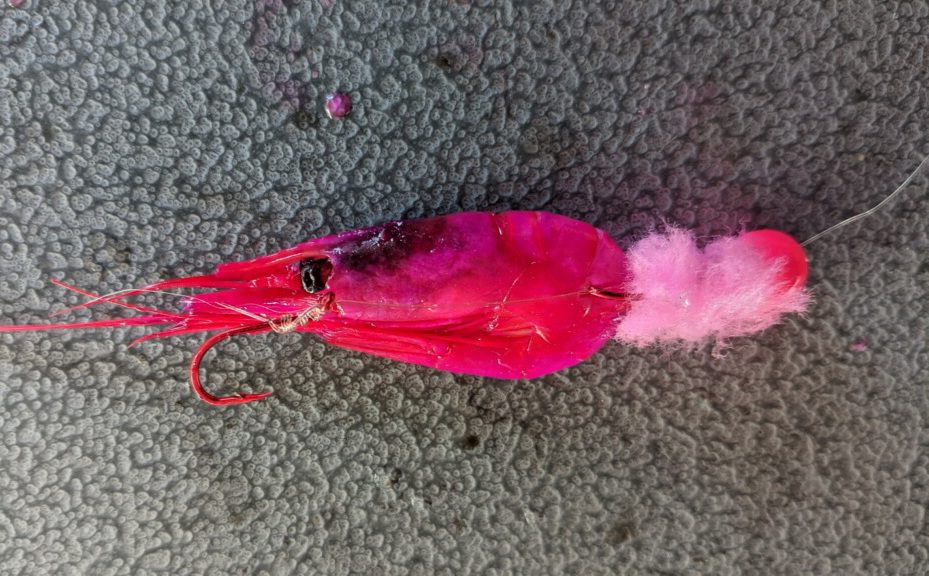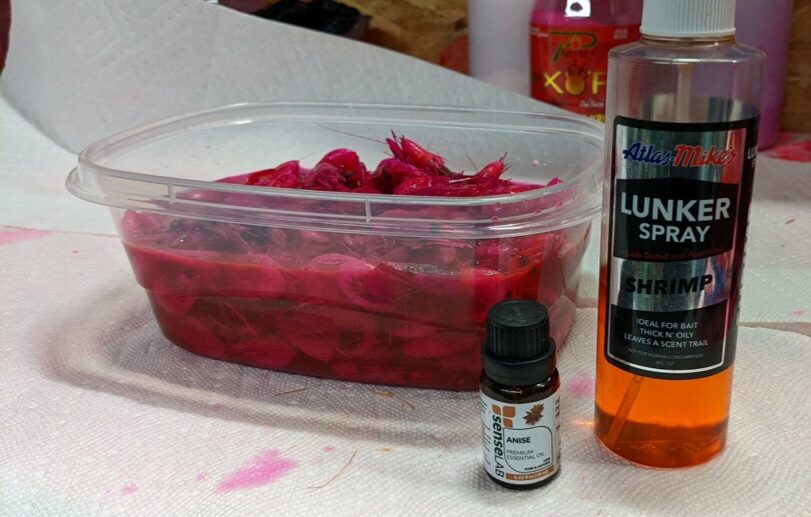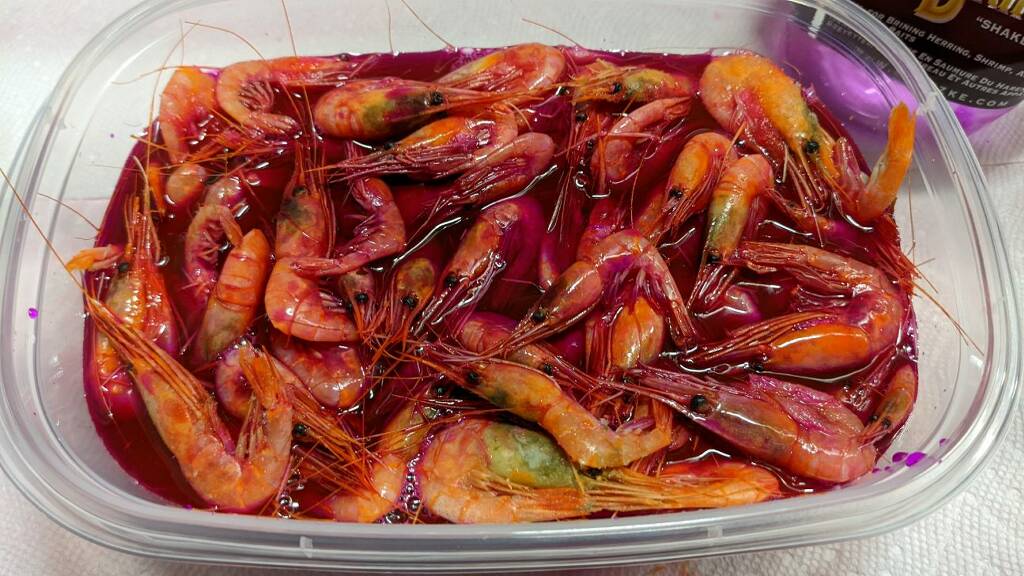Steelhead
Try This Easy Recipe for Perfect Brined Shrimp for Steelhead Success
By: Travis Wendt
We are in the heart of steelhead season and the bite has been good on brined shrimp. Using brined shrimp for bait has been a favorite for countless anglers for as long as I can remember. Meanwhile, we all choose to brine or cure them differently. I’m going to focus on the easy process I prefer. Follow these steps and you’ll have durable, bright, vibrant shrimp that smell exactly the way steelhead like them.
In my experience, this is the best time of year to fish brined shrimp for steelies. The key for us has been cold water. When the water gets cold the shrimp bite gets hot. When the water temperature dips into the low 40s and upper 30s steelhead start biting shrimp. I don’t know what causes them to eat shrimp at these temperatures, but we’ve found this to be true for as long as I can remember. The bite just doesn’t kick in until it gets cold.

Why do the steelhead bite the shrimp? I think it’s just a reaction bite. They’ve been in the ocean munching on shrimp their whole life. When they see one in the river they know that’s what they’ve been eating during their time in the salt. Using shrimp is popular among most anglers. A lot of people run them, especially this time of year. It’s one of the most popular baits out there.

We brine shrimp because coon shrimp right out of the package is inferior. Just like anglers bring herring before fishing them. I brine them because shrimp hold up a lot longer than running regular shrimp and the color makes them stick out more. There’s a lot of competition out there. The better your bait the more fish you’ll catch, theoretically.

Meanwhile, it’s tricky getting them, at least the coon shrimp that we at Reel Time Fishing prefer. Try to contact your local bait shop and ask them if they have coon shrimp. If you can’t find them, any shrimp will work, they just aren’t the best. The most important advice I can give the average angler is to find the best looking bait. The ultimate, perfect coon shrimp is going to have whiskers that are 4-6 inches long. Having the whiskers is ideal, but you don’t always find them because when they freeze they fall off easy. Always remember, if you start with a good bait you are going to end with a good bite.

We fish the coon shrimp three ways: side drifting, back trolled with a diver or tipped on a plug. Basically, I’ll back troll the large ones with the diver and shrimp. With the medium size bait I’ll either side drift them or tip them on a plug.

The Good Stuff: Brine/Cure Shrimp
Step 1: Placing
You can thaw them beforehand, but I start the process with them froze. For starters, it’s important to place the shrimp in anything that seals. This is because you need to rotate them. If you don’t seal them properly you’ll have a mess. Once ready, place the number of shrimp you choose to brine into the container and choose your color of Fire Brine.

Step 2: Time to Brine
I choose to pour Red Fire Brine into a container. Pour enough brine in so it covers all the shrimp. I prefer to use the red because it gives the shrimp a more vibrant look. Some anglers will leave them natural, nevertheless, by using Natural Fire Brine. Early in the season I know guys that use Blue Fire Brine and crush them, but it changes per the system you are in. I’m sure all colors would work depending on water conditions. I’d play around with it more and try other colors, but red is working so well for me, why change?

Step 2: Give It Time to Brine
Brining properly isn’t an overnight process. It takes about a week for the shrimp to brine. You need to make sure to plan for that ahead of time. Let the brine do what it does. The longer you let it brine the better they are going to fish. Usually, after a week they really start taking the cure. Many ask how do you know when the brine is done and the shrimp are fishable? In about a week I’ll pull a shrimp out and feel the firmness with my fingers. If the head falls off when I pull it they aren’t ready, but if the head feels firm and stays on when squeezed they are ready to fish.

I want to stress again how important it is to let the brine work. Part of that process requires flipping them daily. I’ll turn them upside down and the turn it the other way the next day. The reason I do this is the shrimp float to the top because of the salt in the brine. If you don’t rotate them daily the shrimp on top don’t get cured because they’ll float above the brine.

Step 3: To Dye or Not to Dye
At this point they are ready to fish. Personally, I do a few things to make them more attractive to picky steelhead. At this point I’ll sometimes add dye and scent, when I believe it to be necessary. Keep in mind, I often brine several batches and let the steelies tell me what they want. Some are scented, some are different colors and some work better than others.
For example, on cloudy, rainy and snowy days and in darker water conditions the dye would help. This is when I’ll add a squirt of Red Fire Dye to make the bait stand out more. If you are using Chartreuse Fire Brine you can mix it with Chartreuse Fire Dye and so on. In my opinion when the water is clear adding dye isn’t necessary. The brine is enough.

Step 4: Scent Makes Sense
Let’s talk about scent. If you choose to add scent I prefer to do it after the brine is done. And you can believe scent makes a difference. I’m a fan of Atlas Mike’s Shrimp Lunker Spray. I’ll pour about a quarter bottle of it and then add five to six drops of pure anise oil. Afterwards, I’ll shake it up, let the scent mix in with the brine and let them sit overnight.

To Store or Fish?
After they are cured/brined I’ll keep them in the brine if I’m not going to fish them right away. If you aren’t going to use them soon putting them in the freezer is an option. The brine won’t freeze solid with Fire Brine it in. Nonetheless, once I’m ready to fish them, I’ll remove the number of shrimp I think I’m going to use the next few days, drain off the brine and they are ready to fish. The brine will stay good for a month when refrigerated.

*Special Note: This recipe/process will work on any type of shrimp.
Editor’s Note: Travis Wendt is a full-time fishing guide for Reel Time Fishing. To book winter steelhead trips with them please visit https://reeltimefishing.com/







